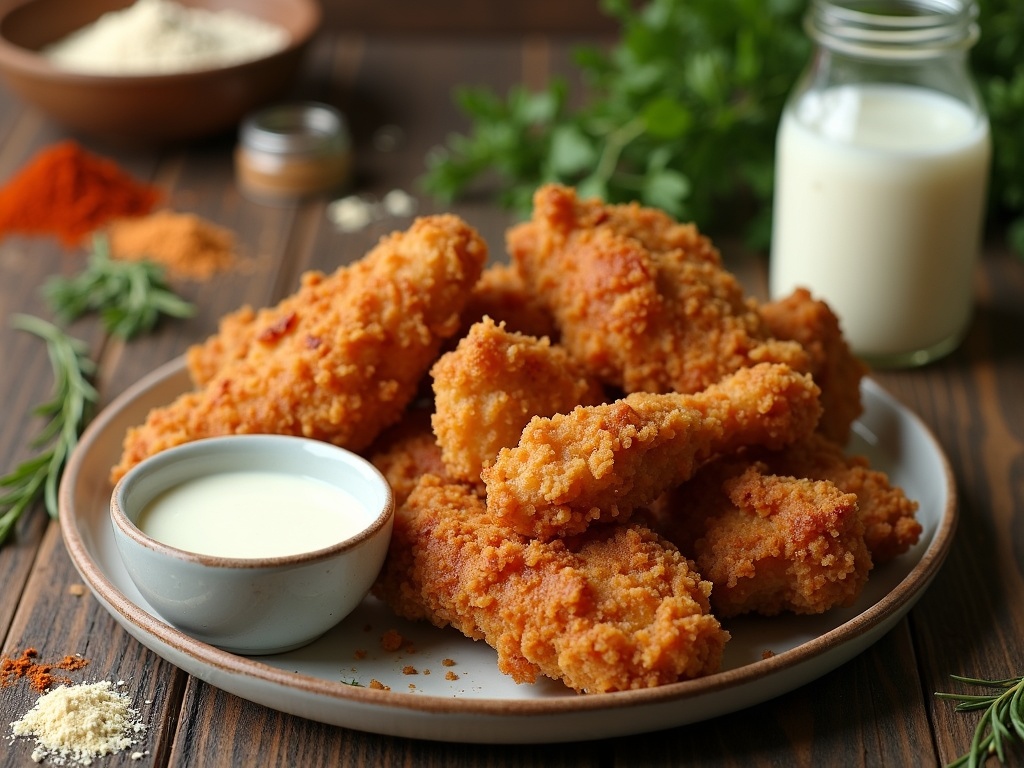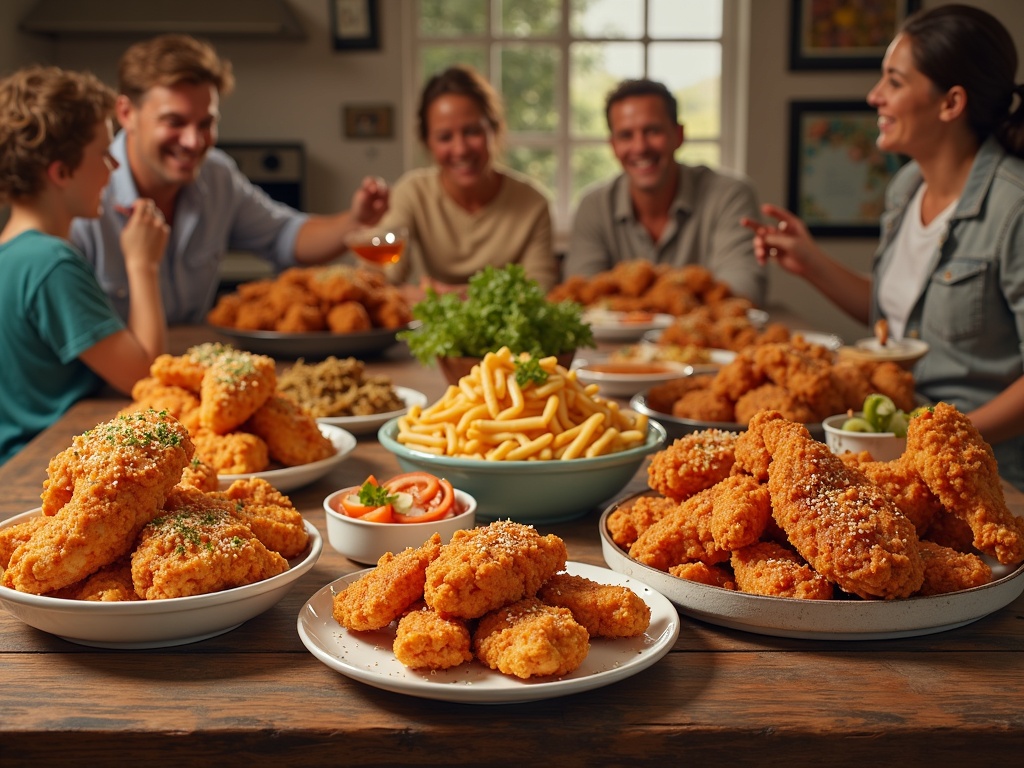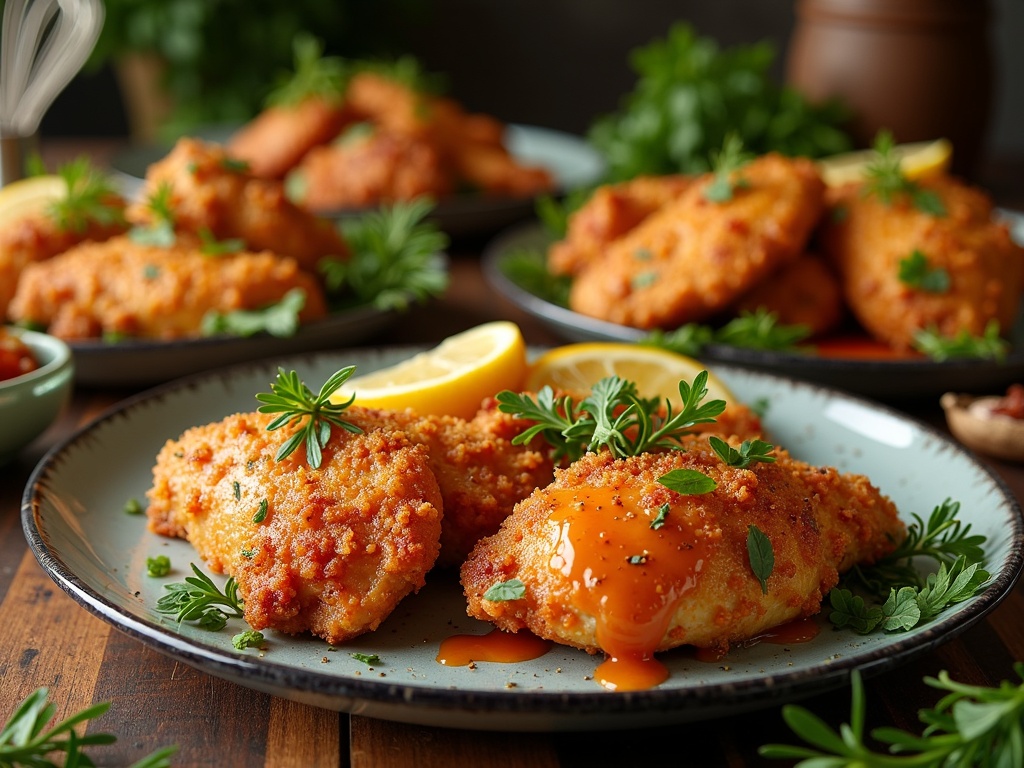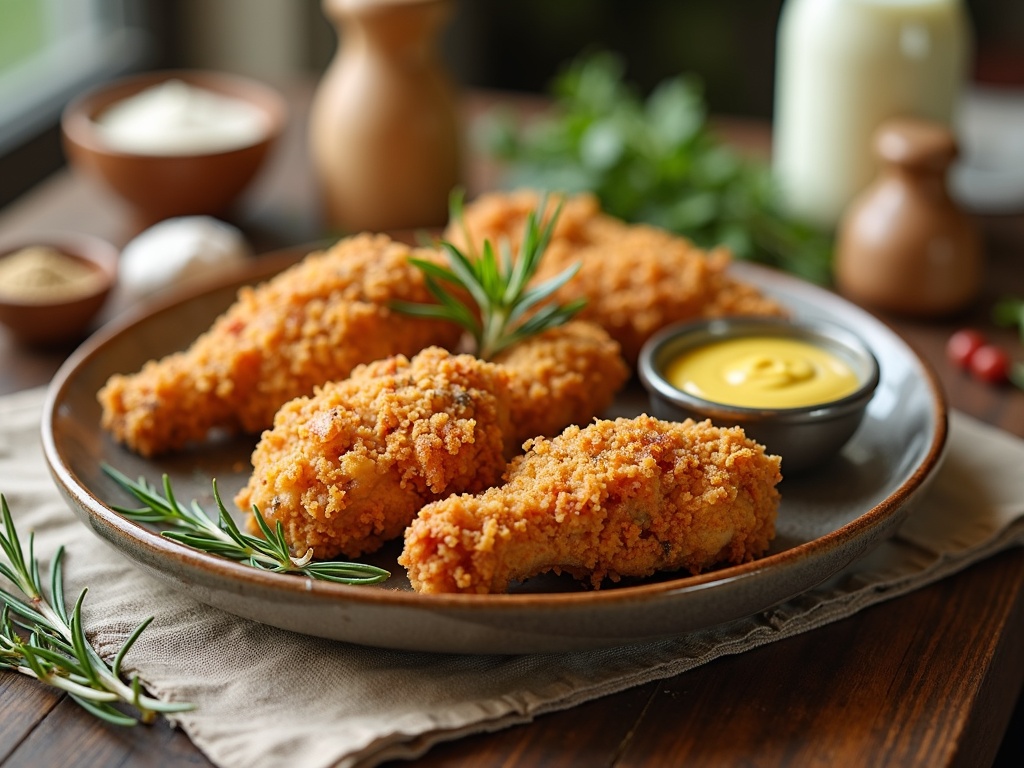Buttermilk chicken combines science and culinary tradition to create uniquely tender, flavorful poultry that has grown from Southern staple to global favorite. The secret lies in buttermilk’s natural acidity, which breaks down protein structures through denaturation, resulting in chicken that’s exceptionally juicy after cooking while providing the perfect foundation for countless flavor variations.
Find In This Article
Key Takeaways
- Marinating chicken in buttermilk for 8-12 hours provides the optimal balance of tenderness and flavor absorption, though timing can range from 2-24 hours depending on desired results.
- The ideal frying temperature for buttermilk chicken falls between 350°F to 375°F to achieve the perfect golden-brown crust without making the chicken greasy.
- Despite its indulgent reputation, buttermilk chicken offers surprising nutritional benefits including approximately 24 grams of protein per serving and essential vitamins like B6 and niacin.
- Double-dredging technique (flour, buttermilk, flour again) creates the crispiest exterior with beautiful craggy edges that provide maximum crunch.
- The versatile dish can be adapted through various cooking methods including traditional deep-frying, oven-baking, air-frying, and grilling to suit different dietary preferences.
The Science Behind Perfect Buttermilk Chicken
Buttermilk is the secret weapon in creating incredibly tender chicken. I’ve found that its natural acidity works wonders on chicken meat by breaking down protein structures in a process called denaturation. This chemical reaction loosens the tough protein bonds, resulting in chicken that practically melts in your mouth after cooking.
The Perfect Marination Timeline
Timing matters tremendously when marinating chicken in buttermilk. The magic happens between 2-24 hours of marination:
- 2-4 hours: Good tenderization with mild flavor penetration
- 8-12 hours: Excellent balance of tenderness and flavor absorption
- 12-24 hours: Maximum tenderization (perfect for tougher cuts)
I don’t recommend marinating longer than 24 hours as the meat can become mushy. For weeknight cooking, I start my buttermilk fried chicken marinade in the morning before work for perfect results by dinner time.
The nutritional profile of buttermilk also enhances your chicken – one cup contains approximately 150 calories, 8g protein, and 11g fat. These components help create a richer flavor profile while adding moisture to the meat.
Spice Combinations That Elevate Buttermilk Chicken
The right spice blend transforms good buttermilk chicken into unforgettable buttermilk chicken. I’ve experimented extensively and found these essential spices create the perfect flavor foundation:
- Garlic powder provides savory depth that complements the tangy buttermilk beautifully.
- Onion powder adds subtle sweetness and complexity.
- Paprika contributes both color and mild heat, while black pepper brings necessary bite and warmth to balance the richness.
I typically use a 2:1:2:1 ratio of garlic powder to onion powder to paprika to black pepper for consistent results. This combination works particularly well in Southern-style fried chicken recipes that depend on buttermilk’s tenderizing properties.
The popularity of buttermilk chicken isn’t just anecdotal – the global fried chicken market is projected to reach $43.6 billion by 2025, with buttermilk preparation methods contributing significantly to this growth. The science-backed benefits of buttermilk marination have made it a standard technique in both home kitchens and professional restaurants.
For a change of pace, I sometimes adapt my buttermilk technique for chicken Kiev recipes, where the tenderizing effects create an exceptionally juicy finished dish around the herb butter center.

Mastering the Perfect Crisp and Temperature
Getting that perfect crispy exterior on buttermilk chicken while keeping the inside juicy requires mastering temperature and technique. I’ve found that maintaining the right heat is absolutely critical for that golden crust everyone craves.
The ideal frying temperature for buttermilk chicken falls between 350°F to 375°F (175°C to 190°C). Too low and your chicken absorbs excess oil, becoming greasy. Too high and you’ll burn the coating before the chicken cooks through. I always recommend using a reliable kitchen thermometer to monitor oil temperature throughout cooking.
Cooking Methods for Every Kitchen
While traditional deep-frying produces that classic crispy texture, several other methods can deliver delicious results:
- Deep-frying: The traditional method that creates the crunchiest coating and most authentic flavor. A standard 3-piece serving contains approximately 500-700 calories when fried.
- Oven-baking: A healthier alternative that still delivers crispiness. I spray the breaded chicken with a light coating of oil before baking at 400°F for about 35-40 minutes.
- Air-frying: Perfect for small batches, air-frying requires minimal oil while still creating a crispy exterior. It’s my go-to for quick weeknight Southern fried chicken dinners.
- Grilling: For a smoky flavor with less oil, try grilling buttermilk-marinated chicken. Just remember to shake off excess marinade before placing on the grill.
The secret to achieving that perfect golden-brown crust starts with proper breading technique. After soaking chicken in buttermilk (preferably overnight), I drain the pieces well but don’t rinse them. The residual buttermilk helps the flour mixture adhere better to the chicken.
For the crispiest results, I use a double-dredging technique: flour first, then back into buttermilk, then into seasoned flour again. This creates those beautiful craggy edges that get extra crispy during cooking. Let the breaded chicken rest for 15-20 minutes before frying to help the coating set.
Temperature control isn’t just about the cooking medium. Starting with room-temperature chicken ensures more even cooking. Cold chicken directly from the refrigerator can lower oil temperature dramatically, resulting in soggy, greasy chicken.
For those looking to expand their chicken recipe collection, chicken Kiev recipes use similar breading techniques but with a delicious butter filling.
Don’t overcrowd your pan when frying. This lowers the oil temperature and creates steam, reducing crispiness. I fry in small batches, maintaining that crucial 350°F-375°F range throughout cooking.
The final secret to maintaining moisture while achieving a perfect crust is proper resting. After cooking, let the chicken rest on a wire rack (not paper towels) for 5-10 minutes. This allows the juices to redistribute throughout the meat while keeping the exterior crisp.
For those worried about calories, consider trying simple chicken breast recipes that use the same buttermilk soaking technique but with leaner cuts.
Remember that dark meat pieces like thighs and drumsticks generally need slightly lower temperatures and longer cooking times than white meat to reach proper doneness without burning the coating. The investment in a good meat thermometer makes all the difference – chicken should reach an internal temperature of 165°F for safe consumption.
With these temperature and technique tips, you’ll create buttermilk chicken with that perfect balance of crispy exterior and juicy interior every time.
Health Benefits You Didn’t Expect
I often hear people describe buttermilk chicken as a guilty pleasure, but there’s more nutritional value in this beloved dish than you might realize. Beyond its mouthwatering taste, buttermilk chicken packs a surprising protein punch, delivering approximately 24 grams of protein per 3.5-ounce (100-gram) serving. This makes it an excellent option for muscle maintenance and overall satiety.
Nutritional Powerhouse
The nutritional benefits of buttermilk chicken extend far beyond just protein. It’s remarkably rich in Vitamin B6 and Niacin, two essential nutrients that support your metabolism and energy production. These B vitamins help convert food into fuel, keeping your energy levels stable throughout the day.
Another often overlooked benefit is selenium content. Chicken is a significant source of this mineral, which acts as an antioxidant in your body, protecting cells from damage and supporting immune function.
For those concerned about making healthier choices while still enjoying this classic dish, I’ve found several adaptations that can boost its nutritional profile:
- Swap traditional white flour for whole wheat flour to increase fiber content
- Use skinless chicken pieces to reduce fat content substantially
- Bake instead of deep-frying after the buttermilk soak
- Add herbs and spices for flavor without extra sodium
- Consider air-frying for a crispy texture with less oil
Portion control also plays a crucial role in enjoying buttermilk fried chicken as part of a balanced diet. A single serving paired with steamed vegetables or a fresh salad creates a more nutritionally complete meal without overdoing calories.
I’ve found that classic fried chicken recipes can be easily modified to retain their flavor while boosting their health benefits. The buttermilk marinade itself offers probiotic properties that can support gut health, especially when using cultured buttermilk.
While traditional chicken kiev and other fried favorites certainly have their place for special occasions, these simple modifications can transform buttermilk chicken from an occasional indulgence into a more regular protein option that contributes positively to your overall nutrition goals.
Southern Comfort Meets Modern Cuisine
I’ve tracked the journey of buttermilk chicken from its humble Southern beginnings to its place on modern menus worldwide. This dish carries rich traditions while adapting to contemporary tastes.
A Deep-Rooted Southern Tradition
Buttermilk chicken sits at the center of Southern United States culinary identity. The dish’s origins trace back to early American settlers who discovered that marinating chicken in buttermilk before frying created an exceptionally tender and flavorful result. The acidic properties of buttermilk break down proteins in the meat, resulting in that signature texture that’s hard to achieve with other marinades.
Family recipes have been treasured and passed down through generations, each with their own secret touch – whether it’s a particular spice blend, specific marinating time, or special frying technique. These recipes often become points of pride and friendly competition at family reunions and community gatherings across the South.
The cultural significance of authentic Southern fried chicken can’t be overstated. It’s featured prominently at the National Fried Chicken Festival in Louisiana, where thousands gather to celebrate this iconic dish. The festival showcases how buttermilk chicken has remained relevant while evolving with changing tastes.
Modern Interpretations and Global Influence
Today’s chefs have taken the traditional buttermilk chicken concept and run with it in exciting directions:
- Korean-inspired versions incorporate gochujang and sesame for a fusion approach
- Nashville hot variations amp up the heat factor with cayenne-based spice blends
- Gluten-free adaptations use alternative flours while maintaining the buttermilk soak
- Baked versions offer lighter alternatives to the classic deep-fried preparation
- Sandwich formats have made buttermilk chicken a fast-casual favorite
Even upscale restaurants have embraced buttermilk chicken, elevating it with premium ingredients and creative presentations. The classic chicken Kiev recipe sometimes incorporates a buttermilk marinade for added tenderness.
What makes buttermilk chicken so enduring is its versatility. The same fundamental technique creates everything from a simple homestyle fried chicken recipe to more complex dishes like marry me chicken with its creamy sauce.
The dish remains a fixture at celebrations big and small – from backyard barbecues to wedding receptions where comfort food stations have become trendy. Its ability to satisfy both nostalgic cravings and contemporary palates ensures that buttermilk chicken will continue evolving while honoring its rich heritage.

Creative Ways to Elevate Your Recipe
I’ve discovered that buttermilk chicken can transform from a simple dish into something extraordinary with just a few clever tweaks. The tangy base creates the perfect canvas for flavor experimentation, allowing you to customize based on mood or occasion.
Flavor Variations That Impress
Honey mustard buttermilk chicken offers a delightful sweet-tangy profile that’s impossible to resist. I mix 3 tablespoons of honey with 2 tablespoons of Dijon mustard into my buttermilk marinade, creating a golden glaze that caramelizes beautifully during cooking. This variation works wonderfully with traditional fried chicken recipes but adds that special something that guests always notice.
For those who enjoy heat, spicy buttermilk chicken delivers serious flavor. I add 2 tablespoons of hot sauce or 1 tablespoon of cayenne pepper to the buttermilk mixture for a kick that balances perfectly with the cooling tang. This approach creates a similar profile to southern fried chicken but with extra dimension from the buttermilk brine.
Looking for a healthier option? My herb-infused buttermilk chicken bakes up crispy and flavorful without excess oil. I blend fresh rosemary, thyme, and sage into the buttermilk marinade, then coat with seasoned panko breadcrumbs before baking at 400°F. The result rivals any simple chicken breast recipe but with significantly more moisture and flavor.
Regional Inspirations and Cooking Methods
Regional variations open up exciting possibilities for buttermilk chicken. Nashville-style uses a cayenne-forward approach with brown sugar for balanced heat. Korean-inspired buttermilk chicken incorporates gochujang and ginger for a fusion twist that works surprisingly well with the tangy base. Mediterranean versions feature lemon, oregano, and garlic for a bright, herbaceous profile similar to chicken Kiev but with distinct buttermilk tenderness.
Alternative cooking methods can adapt buttermilk chicken to various dietary needs. Air-frying creates exceptional crispiness with minimal oil—I preheat to 390°F and cook for about 12 minutes per side. For those avoiding breadcrumbs, almond flour or crushed pork rinds make excellent low-carb alternatives that still achieve that coveted crunch.
The buttermilk tenderizing technique also works beautifully for chicken fried steak and can transform marry me chicken into an even more tender delight. Whatever direction you choose, the buttermilk foundation ensures your chicken remains juicy and flavorful while your creative additions make it uniquely yours.

Sources:
Culinary Institute of America – The Role of Marinades in Cooking
Market Research Analysis – Fried Chicken Trends
USDA FoodData Central – Nutritional Information on Chicken
Southern Foodways Alliance – Cultural Importance of Fried Chicken

